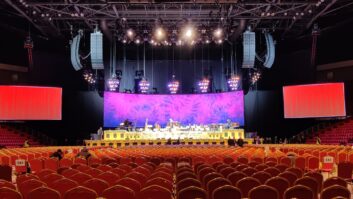
In the first half of this feature we looked at the PA-VA challenges that result from sports teams gaining promotion to a higher league, here David Davies considers the advantages of a decentralised architecture for system overhauls.
In those venues where a complete system renewal is given the go-ahead, a decentralised architecture is likely to be prioritised in order to make future expansion and adaptation as straightforward as possible. More sophisticated processing technology may also be high on the agenda in order to address increased ambient noise levels.
Biamp Systems continues to have a significant presence in the sports venue market thanks to products including Vocia, its decentralised networked paging and voice evacuation solution that is EN54-16 certified and NFPA72 (2016) compliant. Dane Miller, Biamp’s international paging vertical market and business development manager, notes: “Flexibility of configuration and future expansion are two important design criteria that need to be considered when designing and installing any type of stadium audio solution. A decentralised architecture enables expansion [that is] much easier – and less costly – than a traditional centralised model, and has been the preferred system architecture in mid- to large-sized stadium projects. Newer technology like active ambient noise compensation which automatically adjusts the programme level of the amplified sound to the loudspeakers in response to increased crowd size is possible with solutions like Biamp’s Vocia.”
The “vast majority” of new PA systems going into stadiums will run on standard Ethernet networks “and this has easily been the case for the last ten years”, adds Miller. “Stadiums with systems older than that could potentially have PA systems that run in the older analogue domain, making them quite difficult to integrate with newer technology.”
Combined systems
The need to accommodate existing and future requirements is one of the reasons why combined systems which offer both PA and VA capabilities have proven so popular during recent years. They are likely to feature prominently on the shopping list of venues seeking a more comprehensive upgrade, and Miller is among those who is sure that “the trend towards integrated, certified networked PA/VA solutions will continue. The flexibility of these types of systems, along with the life safety certified aspect, allows the end-customer to have the best of both worlds: a highly reliable VA system combined with clear intelligibility. In addition, the operational requirements driving the integration between PA/VA in stadium systems with other platforms (for example, digital signage, building management and VMS) will continue to grow.”
Marc Kocks, business development manager install market at Powersoft is among the others to agree that this trend is bound to intensify. “The integration of PA and VA functionality is the best solution to ensure a safe and quick evacuation of a building/venue. To integrate the PA and VA system special attention has to be given to the system design including redundancy, uninterrupted power supply, fault monitoring and of course audio quality. Powersoft’s application, commissioning and engineering (ACE) department offers tools and support to ensure a design that offers full PA and VA functionality,” he says, adding that these tools include pilot tone monitoring, redundant inputs, fault monitoring and live impedance measurement.
Some believe that this trend towards unified, multipurpose systems will also give venues greater scope to accommodate other sports and entertainment events, including concerts. There is a shift towards installations that have more of the features of “an entertainment system, [enabling use] for other events, and not just football, for example. This will make it possible to create additional revenue for the club or owner,” says Nick Baldwin, sales and marketing director at Baldwin Boxall, who notes that the Baldwin Boxall range includes DSP-controlled PA-VA systems incorporating efficient Class D amplification.
A move up a higher league can occasion an exciting new chapter in a club’s history – and potentially see it reach a far wider audience in the longer term. But in terms of PA-VA capabilities, it brings with it very specific challenges – and ones that are surely best resolved with the assistance and guidance of leading vendor partners, manufacturers and integrators.







